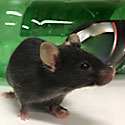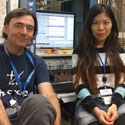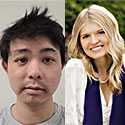Hot Off the Press – August 21, 2025 Published in Nature Neuroscience by Wenhui Zong and Geoffrey Schoenbaum, et al. of the NIDA IRP Behavioral Neurophysiology Neuroscience Section. Summary The orbitofrontal cortex (OFC) and hippocampus (HC) are both thought to contribute to the construction of cognitive maps and their generalization into schemas, yet the nature… [Read More]
Hot off the Press
Locomotor activity depends on β-arrestin recruitment by the dopamine D1 receptor in the striatal D1-D3 receptor heteromer
Hot Off the Press – August, 2025 Published in Pharmacological Research by Alexandra Evans and Sergi Ferré , et al. of the NIDA IRP Integrative Neurobiology Section. Summary It has been long advocated that the mechanism responsible for the classically established cooperative effect of dopamine D1-like and D2-like receptor agonists in the elicitation of locomotor activity… [Read More]
Preexisting risk-avoidance and enhanced alcohol relief are driven by imbalance of the striatal dopamine receptors in mice
Hot Off the Press – January, 2025 Published in Nature Communications by Miriam Bocarsly, Mike Michaelides and Veronica Alvarez, et al. of the NIDA IRP. Summary Alcohol use disorder (AUD) is frequently comorbid with anxiety disorders, yet whether alcohol abuse precedes or follows the expression of anxiety remains unclear. Rodents offer control over the first drink,… [Read More]
A bitopic agonist bound to the dopamine 3 receptor reveals a selectivity site.
Hot Off the Press – October 15, 2024 Published in Nature Communications with contributions from Alessandro Bonifazi , Francisco Battiti and Amy Hauck Newman of the NIDA IRP Medicinal Chemistry Section. Summary We have been designing bitopic ligands for more than two decades with the idea that the secondary pharmacophore would bind in a site… [Read More]
Basal forebrain-lateral habenula inputs and control of impulsive behavior.
Hot Off the Press – August 27, 2024 Published in Neuropsychopharmacology by Eun-Kyung Hwang, Agustin Zapata and Carl Lupica, et al. from the NIDA IRP Electrophysiology Research Section. Summary Impulsive behavior is both a predictor and a consequence of drug use and substance use disorders, as well as a symptom of other neuropsychiatric illnesses such… [Read More]
Presynaptic and Postsynaptic Mesolimbic Dopamine D3 Receptors Play Distinct Roles in Cocaine Versus Opioid Reward in Mice
Hot Off the Press – July 29, 2024 Published in Biological Psychiatry by Zheng-Xiong Xi and Amy Hauck Newman, et al. from the NIDA IRP Addiction Biology Unit. Summary Dopamine D3 receptors (D3Rs) play pivotal roles in the rewarding effects of cocaine and opioids. However, the cellular and neural circuit mechanisms in the brain underlying… [Read More]
Incubation of methamphetamine craving in punishment-resistant individuals is associated with activation of specific gene networks in the rat dorsal striatum
Hot Off the Press – April 24, 2024 Published in Molecular Psychiatry by Atul Daiwile and Jean Lud Cadet, et al. from the NIDA IRP Molecular Neuropsychiatry Section. Summary Methamphetamine also called METH, crank, ice etc. is a powerful stimulant that has caused addiction in a lot of people in the world. Humans who take… [Read More]
Different Effects of Peer Sex on Operant Responding for Social Interaction and Striatal Dopamine Activity
Hot Off the Press – April 18, 2024 Published in The Journal of Neuroscience by Jonathan Chow, Kayla Pitts and Yavin Shaham, et al. from the NIDA IRP Neurobiology of Relapse Section. Summary Recent studies have shown that when rats are given a mutually exclusive choice between social interaction with a peer and an addictive… [Read More]
Midbrain signaling of identity prediction errors depends on orbitofrontal cortex networks
Hot Off the Press – April 10, 2024 Published in Nature Communications by Qingfang Liu and Thorsten Kahnt, et al. from the NIDA IRP Learning and Decision-Making Unit. Summary In this study, Qingfang Liu (Research Fellow in the LDMU) and colleagues show that identity prediction errors in the dopaminergic midbrain are computed based on outcome… [Read More]
GPR55 is expressed in glutamate neurons and functionally modulates drug taking and seeking in rats and mice
Hot Off the Press – April 4, 2024 Published in Translational Psychiatry by Yi He, Hui Shen and Zheng-Xiong Xi, et al. from the NIDA IRP Addiction Biology Unit and Magnetic Resonance Imaging and Spectroscopy Section. Summary G protein-coupled receptor 55 (GPR55) is a putative cannabinoid receptor, which has been considered as the “CB3” receptor, as… [Read More]










